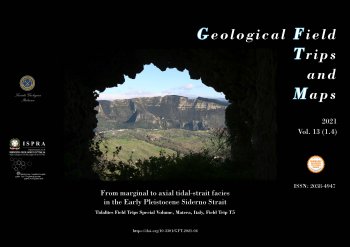
Volume 13 (1.4)/2021
From marginal to axial tidal-strait facies in the Early Pleistocene Siderno Strait
Tidalites Field Trips Special Volume, Matera, Italy, Field Trip T5
DOI: https://doi.org/10.3301/GFT.2021.04 - Pages: 1-51
Sergio G. Longhitano (1), Valentina M. Rossi (2), Domenico Chiarella (3), Donatella Mellere (4), Francesco Muto (5) & Vincenzo Tripodi (5)
(1) - Department of Sciences, University of Basilicata, Potenza, Italy.
(2) - National Research Council of Italy, Institute of Geosciences and Georesources, Italy.
(3) - Clastic Sedimentology Investigation (CSI), Department of Earth Sciences, Royal Holloway, University of London, UK.
(4) - DNO E&P, Stavanger Norway.
(5) - Department of Biology, Ecology and Earth Sciences, University of Calabria, Cosenza, Italy.
Corresponding author e-mail: sergio.longhitano@unibas.it
(2) - National Research Council of Italy, Institute of Geosciences and Georesources, Italy.
(3) - Clastic Sedimentology Investigation (CSI), Department of Earth Sciences, Royal Holloway, University of London, UK.
(4) - DNO E&P, Stavanger Norway.
(5) - Department of Biology, Ecology and Earth Sciences, University of Calabria, Cosenza, Italy.
Corresponding author e-mail: sergio.longhitano@unibas.it
Abstract
This geological guide presents the description of locations associated with a two-day field trip arranged in relation to the 10th International Congress of Tidal Sedimentology (Tidalites), Matera, Italy. The field guide describes sedimentological features of the largest among a series of tectonically controlled tidal straits that dissected the Calabrian Arc in southern Italy during the Early Pleistocene. The WNW-ESE trending, 50x20 km- wide Siderno Strait connected the Tyrrhenian with the Ionian seas. Due to tidal phase opposition between the two basins, continuous water-mass exchanges occurred through the strait, leading to powerful, bi-directionally flowing tidal currents. Sediments filling the Siderno Strait derived from both fluvial supply from the margins and intra-basinal autochthonous carbonate-factory debris. The main objective of the two-day field trip is to guide the visitor through a cross-section of the ancient strait, starting from one of the margins, ending in the deeper axial zone. The focus during the day one is on strait-margin deltaic fluvial-dominated deposits, shed from the tectonically-controlled, northern border and reworked by tidal currents in their distal reaches (delta front). Erosively-based, 4–5 m-thick pebbly-sandstone strata intercalated with 2–3 m-thick tidally-generated cross strata stack into a ca. 170 m-thick succession, exposed in a series of outcrops progressively located down-current with respect to the inferred entry point to the north. The focus of the day two is a ca. 150–190 m-thick succession consisting of cross-stratified mixed (bioclastic-siliciclastic) deposits, forming a series of WNE-ESE-oriented, elongated ridges that accumulated in the south-eastern axial zone of the Siderno Strait. The selected stops offer panoramic views of exceptionally continuous sections and close-up observations, revealing different scales of depositional architectures and a variety of sedimentary structures and trace fossils that record the development of these tidal sand ridges during the strait lifespan. The interplay between the tectonic uplift of a central bedrock sill and a number of syn-sedimentary faults and high-frequency relative sea- level changes (induced by glacio-eustacy and active tectonics) can be deciphered from the architecture of the tidally-generated cross strata composing the main body of the ridges.
Keywords
Tidal cross stratification, tectonic control, tidal currents, strait-margin zone, dune-bedded zone, tidal sand ridges, Calabria, southern Italy.
